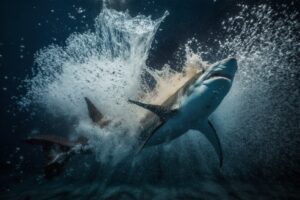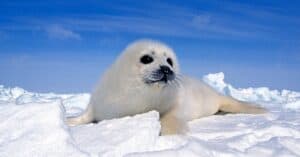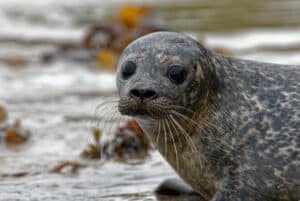Leopard seals are fascinating creatures to observe. They have a long body, a large head, and an enormous jaw to capture their prey. Leopard seals are carnivores and consume krill, fish, squid, penguins, and seabirds. Male seals can weigh up to 660 pounds and can be as long as 10.7 feet long, whereas females can weigh up to 1,100 pounds and can grow up to 11.7ft in length. These seals has a lifespan of twelve to fifteen years. Leopard seals are found in waters off the coast of Antarctica and will occasionally drift into other areas in search of food. A fun fact about the leopard seal is that their scientific name, Hydrurga leptonyx, means “slender clawed water worker!
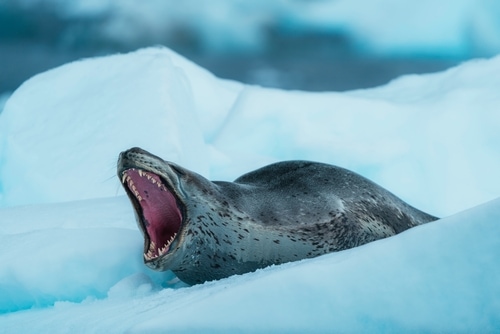
The Leopard seals powerful jaw aids them in capturing their food. They will hold their prey in their mouth and shake their head from side to side causing the prey to breakdown to pieces.
©James_Castleden/Shutterstock.com
How Big Are Leopard Seals When They Are Born?
Female seals are usually ready to breed between two and six years old, whereas the males are between three and seven years. Seals give birth between November and January. Females have delayed implantation, meaning after mating the egg is fertilized after three months. Delayed implantation happens so the pup is born during optimal temperatures. At birth the pup can weigh up to 77 pounds and 3 to 5 feet long. Pregnant leopard seals are typically pregnant for eleven months and give birth to one pup on the ice. After three weeks, the pup will start learning how to haunt in the water.
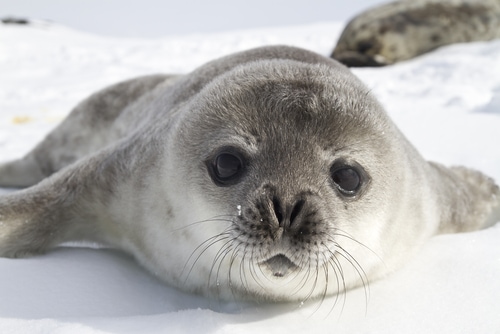
Baby Leopard seals shed their first coat after three weeks of being born.
©Tarpan/Shutterstock.com
Phocid
There are nineteen species of Phocids. “True seals” or “earless seal” are names used for Phocids. Phocids have the name earless seals because they lack the external part of the ear. The largest type of earless seal is the male southern elephant seal weighing 8,800 pounds and 19 Feet long. Compared to a male hippopotamus, the male southern elephant seal are about the same in relation to length and weight. A male hippo can weigh up to 9,920 pounds and get up to 16.5 feet long. The ring seal is the smallest of this species weighing up to 154 pounds and 5 feet long. A fun fact about the earless seal is that they can not rotate their hind flippers under their bodies, which is why it appears as they are walking like caterpillars on land.

Otariid
There are fourteen species of the otariid or “eared seals.” Otariid is derived from the greek word “otario“, meaning little ears. Unlike the earless seals, Otariids can rotate their flippers allowing them to walk and climb on land. While swimming, the otariids swim with their front flippers while using their rear flippers as propellers for steering. The largest otariid is the stellar sea lion weighing up to 2,200 pounds and can exceed 9 feet. Relative to size, a BMWs weight and length outrank this seal. A BWM weighs around 3,400 pounds and is about 16 feet in length! These creatures live on the coasts of northern Asia, New Zealand, North America and South America. The skull size of this seal is relative in size to a bear. These seals like to eat fish, cephalopods, and crustaceans.

Odobenid
There is only one species of the Odobenids and that is the walrus. Walruses do not have a external ear; however, they are able to walk and climb on land similar to the eared seals. These creature live around the arctic circles of the Atlantic and Pacific oceans. Walruses are known for their long tusks and blubber to keep warm in arctic temperatures. Walruses can weigh up to 3,00 pounds and grow to 11.5 feet long. A small African Elephant is double the weight of a walrus and is almost the same length.
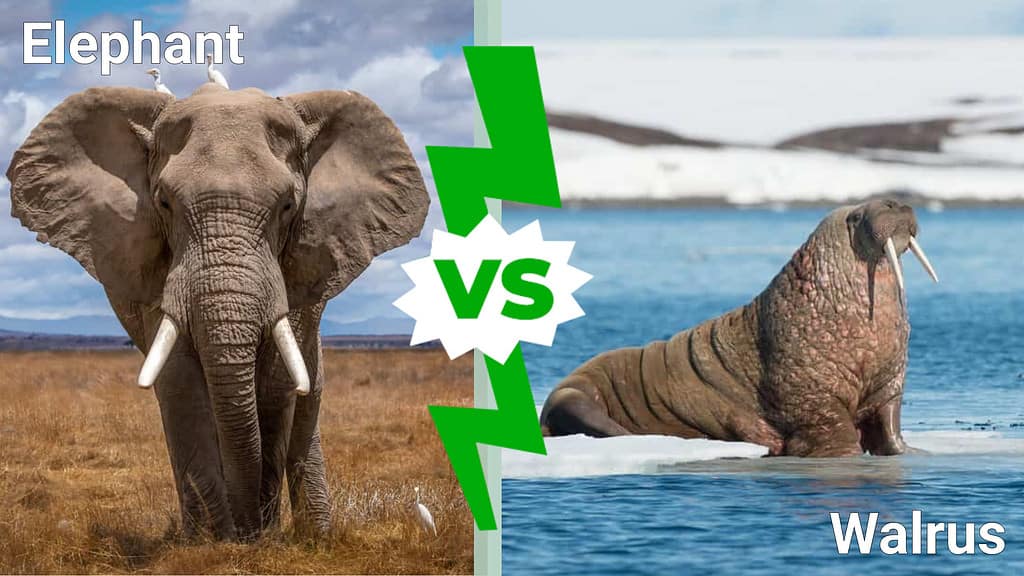
The Largest Leopard Seal Recorded
Although the southern elephant seal is the biggest type of seal, they are not the ones making headline! Normally the females seals are either bigger or the same size of the males. The Costa Lab is a research group that keep track of marine life and environment. This research group captured a female seal that weighs 1,188 pounds and is 10.5 feet long. Bigonia is the biggest leopard seal that has ever been weighed at Cape Shirreff!
The photo featured at the top of this post is © B.navez / Creative Commons / Original
Thank you for reading! Have some feedback for us? Contact the AZ Animals editorial team.




